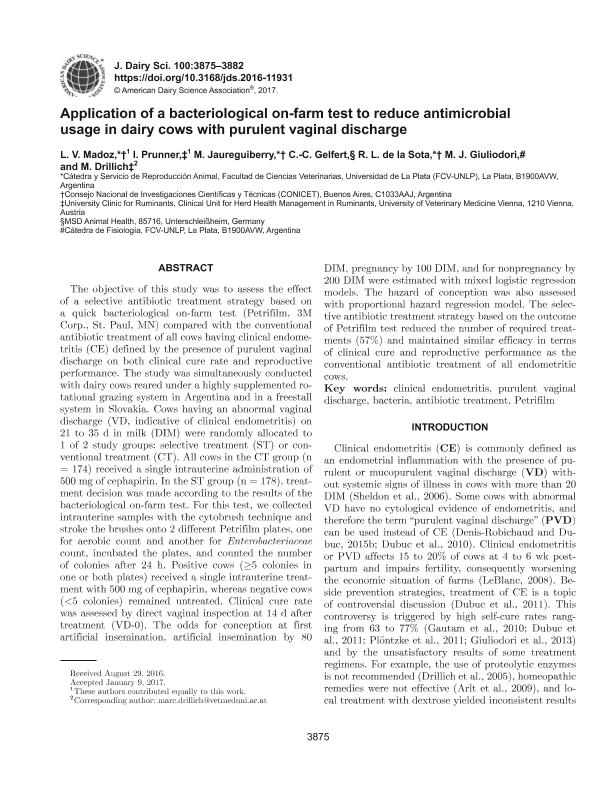Artículo
Application of a bacteriological on-farm test to reduce antimicrobial usage in dairy cows with purulent vaginal discharge
Madoz, Laura Vanina ; Prunner, I.; Jaureguiberry, María
; Prunner, I.; Jaureguiberry, María ; Gelfert, C. C.; de la Sota, Rodolfo Luzbel
; Gelfert, C. C.; de la Sota, Rodolfo Luzbel ; Giuliodori, Mauricio Javier; Drillich, M.
; Giuliodori, Mauricio Javier; Drillich, M.
 ; Prunner, I.; Jaureguiberry, María
; Prunner, I.; Jaureguiberry, María ; Gelfert, C. C.; de la Sota, Rodolfo Luzbel
; Gelfert, C. C.; de la Sota, Rodolfo Luzbel ; Giuliodori, Mauricio Javier; Drillich, M.
; Giuliodori, Mauricio Javier; Drillich, M.
Fecha de publicación:
05/2017
Editorial:
American Dairy Science Association
Revista:
Journal of Dairy Science
ISSN:
0022-0302
Idioma:
Inglés
Tipo de recurso:
Artículo publicado
Clasificación temática:
Resumen
The objective of this study was to assess the effect of a selective antibiotic treatment strategy based on a quick bacteriological on-farm test (Petrifilm, 3M Corp., St. Paul, MN) compared with the conventional antibiotic treatment of all cows having clinical endometritis (CE) defined by the presence of purulent vaginal discharge on both clinical cure rate and reproductive performance. The study was simultaneously conducted with dairy cows reared under a highly supplemented rotational grazing system in Argentina and in a freestall system in Slovakia. Cows having an abnormal vaginal discharge (VD, indicative of clinical endometritis) on 21 to 35 d in milk (DIM) were randomly allocated to 1 of 2 study groups: selective treatment (ST) or conventional treatment (CT). All cows in the CT group (n = 174) received a single intrauterine administration of 500 mg of cephapirin. In the ST group (n = 178), treatment decision was made according to the results of the bacteriological on-farm test. For this test, we collected intrauterine samples with the cytobrush technique and stroke the brushes onto 2 different Petrifilm plates, one for aerobic count and another for Enterobacteriaceae count, incubated the plates, and counted the number of colonies after 24 h. Positive cows (≥5 colonies in one or both plates) received a single intrauterine treatment with 500 mg of cephapirin, whereas negative cows (<5 colonies) remained untreated. Clinical cure rate was assessed by direct vaginal inspection at 14 d after treatment (VD-0). The odds for conception at first artificial insemination, artificial insemination by 80 DIM, pregnancy by 100 DIM, and for nonpregnancy by 200 DIM were estimated with mixed logistic regression models. The hazard of conception was also assessed with proportional hazard regression model. The selective antibiotic treatment strategy based on the outcome of Petrifilm test reduced the number of required treatments (57%) and maintained similar efficacy in terms of clinical cure and reproductive performance as the conventional antibiotic treatment of all endometritic cows.
Archivos asociados
Licencia
Identificadores
Colecciones
Articulos(CCT - LA PLATA)
Articulos de CTRO.CIENTIFICO TECNOL.CONICET - LA PLATA
Articulos de CTRO.CIENTIFICO TECNOL.CONICET - LA PLATA
Citación
Madoz, Laura Vanina; Prunner, I.; Jaureguiberry, María; Gelfert, C. C.; de la Sota, Rodolfo Luzbel; et al.; Application of a bacteriological on-farm test to reduce antimicrobial usage in dairy cows with purulent vaginal discharge; American Dairy Science Association; Journal of Dairy Science; 100; 5; 5-2017; 3875-3882
Compartir
Altmétricas



